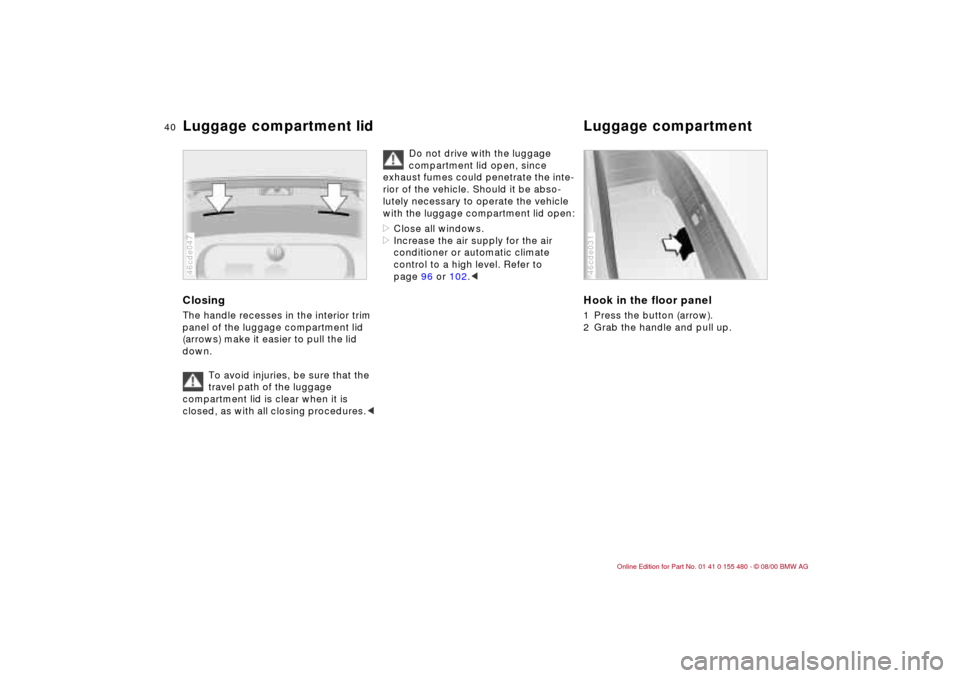2001 BMW 330Ci CONVERTIBLE ABS
[x] Cancel search: ABSPage 11 of 215

11n
Controls and features
Operation, care and maintenance
Lamps:
Side lamps/Low beams93
Instrument panel lighting93
High beams/Parking lamps94
Fog lamps94
Interior lamps94
Controlling the climate
for pleasant driving:
Air conditioner96
Automatic climate control102
Seat heating107
Interior convenience:
Glove compartment107
BMW Universal Transmitter108
Storage facilities110
Cellular phone111
Ashtray, front111
Cigarette lighter112
Ashtray, rear112
Loading and transporting:
Ski bag113
Cargo loading114
Roof-mounted luggage rack for
the hardtop116
Special operating instructions:
Break-in procedures120
Driving notes121
Catalytic converter121
Antilock Brake System
(ABS)122
Disc brakes125
Brake system126
Winter operation127
Power steering129
Cellular phone129
Radio reception129
Hardtop130
Wheels and tires:
Tire inflation pressure132
Tire condition132
Tire replacement133
Tire rotation134
Wheel and tire
combinations135
Winter tires136
Snow chains136
Approved wheel and tire
specifications137
Under the hood:
Hood140
Engine compartment142
Washer fluids144
Washer nozzles144
Engine oil145
Coolant147
Brake fluid148
Vehicle Identification
Number149
Care and maintenance:
The BMW Maintenance
System150
Caring for your vehicle151
Cleaning and care of the
convertible top157
Airbags159
Vehicle storage160
Laws and regulations:
Technical modifications161
California Proposition
65 Warning161
ODB interface socket162
Page 19 of 215

19n
IndexDataTechnologyRepairsCar careControlsOverview
Instrument cluster
1 Fuel gauge with indicator lamp
for fuel reserve82
2 Turn signal indicator23
3 Speedometer
4 Indicator lamp for:
>
Battery charge current20
>
High beams23
>
Engine oil pressure/Engine oil
level20, 22
5 Tachometer and
Energy control81
6 Engine coolant temperature gauge
with "Coolant temperature too high"
indicator82
7 Indicator and warning lamps (clock-
wise) for:
>
Parking brake/Brake hydraulic
system/Cornering Brake Control
(CBC)/DBC20
>
Antilock Brake System (ABS)22
>
Brake pads22
>
Tire Pressure Control
(RDC)
*
20, 22
>
Rollover protection system67
>
Airbags21
>
Adjust and lock backrest/Please
fasten safety belts21
>
Cruise control23
8 Set button for the clock849 Program display for automatic
transmission
*
75
Indicator lamp for automatic
transmission
*
21, 75
10 Indicator lamp for Automatic
Stability Control plus Traction
(ASC+T)/Dynamic Stability Control
(DSC)
*
and ADB22
11 Indicator for:
>
Odometer81
>
Trip odometer81
>
Clock84
>
Service Interval82
Indicator for computer,
operation using the turn signal lever,
refer to page 83:
>
Clock
>
Outside temperature
>
Average fuel consumption
>
Range
>
Average speed
12 Indicator for Check Control83
13 Trip odometer, reset to zero8114 Indicator and warning lamps (clock-
wise) for:
>
Front fog lamps23
>
Add washer fluid22
>
Coolant level23
>
Electronic Throttle Control
(EML)
*
23
>
Service engine soon22
You can display the outside
temperature and distance driven
in different units of measurement.
<
Page 21 of 215

21n
IndexDataTechnologyRepairsCar careControlsOverview
Indicator and warning lampsRed and yellow: continue driving
cautiously
The brake warning lamp and the
yellow indicator lamps for ABS
and ASC+T/DSC both light up:
The entire ABS, CBC, ASC+T/
DSC
and
ADB/DBC system has
failed. Continue driving
cautiously and defensively.
Avoid hard brake applications.
Please have the system checked by
your BMW center as soon as possible.
For additional information, refer to
pages 88, 123.
CBC, ABS, ASC+T/DSC
indi-
cator and warning lamps for
Canadian models.
Red: an important reminder
Parking brake
Comes on when the parking
brake is applied Ð an acoustic
signal also sounds when starting off.
For additional information, refer to
page 71. Parking brake warning lamp for
Canadian models.
Adjust and lock backrest/Please
fasten safety belts l
A warning signal will sound at
the same time. Flashes, if the backrest
is not locked. Lights up until the safety
belt is fastened.
For additional information on safety
belts, refer to page 60.
Airbags l
Please have the system
inspected by your BMW center.
For additional information, refer to
pages 61, 189.
Orange: consult the nearest BMW
center
Automatic transmission
Because of a malfunction, the
automatic transmission shifts
only in the emergency program. Please
consult the nearest BMW center.
For additional information, refer to
page 75.
Page 22 of 215

22n
Indicator and warning lampsYellow: check as soon as possible
Antilock Brake System (ABS) l
ABS has been deactivated in
response to system malfunction.
Conventional braking efficiency is avail-
able without limitations. Please have
the system inspected by your BMW
center.
For additional information, refer to
page 123.
ABS warning lamp for Canadian
models.
Engine oil level
Lights up while driving:
The oil level is at the absolute
minimum; therefore, add engine oil as
soon as possible. Do not drive more
than 30 miles (50 km) until you do.
For additional information, refer to
page 145.
Engine oil level
Comes on after the engine has
been shut off: add oil at the
earliest opportunity (when you stop to
refuel).
For additional information, refer to
page 145.
Brake pads l
Have the brake pads checked.
For additional information, refer
to page 126.
Tire Pressure Control (RDC) l
Check tire inflation pressure:
refer to pages 27, 91.
Automatic Stability Control
plus Traction (ASC+T)/Dynamic
Stability Control (DSC l
Indicator lamp flashes:
The system is active and governs drive
force and braking force.
The indicator lamp remains on:
ASC+T has been switched off via the
button or it is defective, or the DSC has
been switched off, ADB is operational.
Please consult the nearest BMW center
in the event of a fault.
For additional information, refer to
page 88.
Automatic Stability Control plus
Traction (ASC+T)/Dynamic
Stability Control (DSC) and
brake warning lamp l
The indicator lamps remain on:
DSC
and ADB/DBC are
switched off via the button or are defec-
tive.
Please consult the nearest BMW
center.
For additional information, refer to
page 88.
DSC and ADB/DBC indicator
and warning lamps for Canadian
models.
Add washer fluid.
The washer fluid is too low. Top
up the fluid at the earliest
opportunity.
For additional information, refer to
page 144.
Service Engine Soon l
If the indicator lamp comes on
either continuously or intermit-
tently, this indicates a fault in the emis-
sions-related electronic systems.
Although the vehicle remains opera-
tional, you should have the systems
inspected by your BMW center at the
earliest possible opportunity.
For additional information, refer to
page 162.
Service Engine Soon warning
lamp for Canadian models.
Page 40 of 215

40n
Luggage compartment lid Luggage compartmentClosingThe handle recesses in the interior trim
panel of the luggage compartment lid
(arrows) make it easier to pull the lid
down.
To avoid injuries, be sure that the
travel path of the luggage
compartment lid is clear when it is
closed, as with all closing procedures.<46cde047
Do not drive with the luggage
compartment lid open, since
exhaust fumes could penetrate the inte-
rior of the vehicle. Should it be abso-
lutely necessary to operate the vehicle
with the luggage compartment lid open:
>Close all windows.
>Increase the air supply for the air
conditioner or automatic climate
control to a high level. Refer to
page 96 or 102.<
Hook in the floor panel1 Press the button (arrow).
2 Grab the handle and pull up.46cde031
Page 68 of 215

68n
Rollover protection system3 Continue pressing down on the
protective bar (1) from above until
you hear it click into place.
4 Replace the cover panel and press
down firmly.
5 Press the rear section of the headrest
closed (2).46cde035
Do the same for the second protective
bar. If you are not familiar with these
procedures, consult your BMW center.
Have the rollover protection system
checked by your BMW center after it
has been inadvertently triggered.
Do not move the convertible top
under any circumstances if the
rollover protection system has
extended.
Do not use the rear headrests as
storage shelves.
Absolutely no modifications are to be
made to any of the rollover protection
system's individual components or any
of its wiring.
Only your BMW center is to carry out
any work on the rollover protection
system.
Work done on the system that is carried
out improperly could lead to failure in
an emergency or accidental airbag acti-
vation.
To have the system checked and to
ensure long-term operation: be sure to
adhere to the Service Interval Display
for maintenance intervals. Every 2 years
at the latest, the rollover protection
system must be inspected by a BMW
center.c
Page 119 of 215

Overview
Controls and features
Operation, care
and maintenance
Owner service procedures
Technical data
Index Advanced technology
119n
IndexDataTechnologyRepairsCar careControlsOverview
Special operating instructions:
Break-in procedures120
Driving notes121
Catalytic converter121
Antilock Brake System
(ABS)122
Disc brakes125
Brake system126
Winter operation127
Power steering129
Cellular phones129
Radio reception129
Hardtop130
Wheels and tires:
Tire inflation pressure132
Tire condition132
Tire replacement133
Tire rotation134
Wheel and tire
combinations135
Winter tires136
Snow chains136
Approved wheel and tire
specifications137Under the hood:
Hood140
Engine compartment142
Washer fluids144
Washer nozzles144
Engine oil145
Coolant147
Brake fluid148
Vehicle Identification
Number149
Care and maintenance:
The BMW Maintenance
System150
Caring for your vehicle151
Cleaning and care of the
convertible top157
Airbags159
Vehicle storage160
Laws and regulations:
Technical modifications161
California Proposition
65 Warning161
OBD interface socket162
Car care
Page 122 of 215

122n
Antilock Brake System (ABS)The concept ABS enhances active safety by helping
to prevent the wheels from locking
under braking. This is because locked
wheels are dangerous. When the front
wheels slide, the driver loses steering
control over the vehicle. Traction loss at
the rear wheels can cause the rear end
to break into an uncontrolled skid.
The system can achieve the shortest
braking distances possible under most
conditions (on straight-aways and in
curves, on asphalt, ice, wet road
surfaces, etc.).
ABS is designed to meet two essential
requirements during every brake appli-
cation:
>To help provide vehicle stability.
>To help maintain steering control and
maneuverability Ð on all types of road
surfaces (asphalt, concrete, mud, wet
road surfaces, snow, ice).
Braking with ABSAt about 6 mph (10 km/h), the system
becomes operative. Whenever the
vehicle's speed drops below approx.
4 mph (6 km/h), the ABS is deactivated.
This means that the wheels can lock in
the final phase of a panic stop Ð a factor
of no significance in actual use.
If you are in a situation that requires full
braking, you will exploit the full benefits
of the ABS system if you apply maxi-
mum brake pressure ("panic stop").
Since the vehicle maintains steering
responsiveness, you can nevertheless
avoid possible obstacles with a
minimum of steering effort.
The ABS system closed-loop control
circuit cycles in fractions of a second.
A pulsation at the brake pedal, together
with the sounds associated with the
hydraulic controls, tells you that the
brake system is within its maximum
limit range and reminds you that you
should adapt road speed to the road
conditions.
On road surfaces that have a loose
surface layer on a firm base with good
traction (on gravel or snow, for
example), or when snow chains are
mounted, braking distances may be
longer than with locked wheels. Nevertheless, ABS possesses the
advantage of vehicle stability and
steering response.
Information for your safetyNot even ABS can suspend the laws of
physics. ABS cannot prevent the
consequences of brake applications
with inadequate clearances for safety
between vehicles, when exceeding the
speed limit, or the risks involved when
aquaplaning occurs. Responsibility for
these types of situations remains in the
hands (and at the feet) of the driver. You
should never allow the added safety of
ABS to lull you into a false sense of
security, or mislead you into taking
increased risks.
Do not make any modifications to
the ABS system.
Service procedures on ABS are to be
performed by authorized technicians
only.<